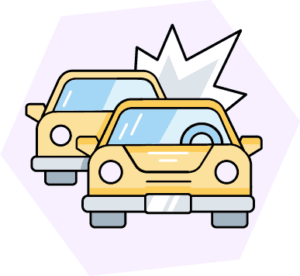What Should You Do After a Car Accident That’s Not Your Fault?
Car wrecks often prove to be a scary and confusing experience, especially if the accident is not your fault. If somebody crashes into you, follow these steps to ensure the greatest possible outcomes:
- Get to Safety
- Inspect Yourself and Your Passengers for Injuries
- Call 911
- Exchange Information
- Document Damage to Vehicles
- Notify Your Insurer
- Notify the DMV (depending on the state and situation)
- Medical Checks
The many nuances involved in a car crash can make one challenging to navigate and further complicate the claims process. Knowing how to handle an unforeseeable accident on the fly can ensure your safety and save you valuable time and money during an already stressful period.
Table of Contents
How Is Fault Determined in a Car Accident?
After a car accident, each insurance company will compile all available evidence to determine the “at-fault” driver. These data points include their clients’ telling of events, witness testimony, traffic cameras, police reports, and particular vehicular damages. Once these companies finish their investigation and negotiation, they will often pay their clients separately.
Depending on the state, the at-fault party’s insurance company will pay the damages instead of making the not-at-fault party subrogate. At-fault drivers receive a long-lasting (3-5 years) mark on their record, triggering higher insurance premiums at your next renewal.
Your Next Steps After An Accident
Follow these steps to ensure proper handling of a car accident on the scene and in the following days.
Immediately After the Accident
After an accident, prioritize your safety above all else. Car accidents often occur in high-traffic areas, such as bends in the highway or congested intersections. Other cars on the road may not immediately realize what has happened before them, so the afflicted drivers must clear the area as quickly as possible. Moving yourself, your passengers, and your vehicle safely out of traffic can save the lives of other drivers and prevent further personal harm.
Get to Safety
First, if you can, move your car to the side of the road to clear a lane for traffic and avoid another collision. If your vehicle proves inoperable, turn off your engine and turn on your hazards. Abandon your car and quickly get yourself and your passengers to a nearby location out of the street. However, if you have severe injuries, try not to move and wait for help.
Inspect Yourself and Your Passengers for Injuries
Next, inspect yourself and your passengers for blood, bruising, or broken bones. If anybody seems seriously hurt, call 911. In some cases, the driver may have sustained the worst injuries, and their passengers will have to get them medical help. Everybody in your vehicle is responsible as a witness, so uninjured passengers should remain on the scene while you talk to authorities and exchange insurance information.
Call 911

Whether or not somebody got hurt, many states require both drivers to call 911 immediately after relocating to a safe location. The responding officers can help reroute traffic, clear the scene, and complete an accident report. After you file a claim with your insurer, this report will help them determine fault and the proper reimbursement of damages.
After You Are No Longer In Physical Danger
After removing yourself and your vehicle from harm’s way, you can exchange insurance information with the other driver and thoroughly document the damages to both cars. Failing to do so before leaving the accident scene could negatively impact your insurance claim and result in an insufficient payout for your medical bills and repair fees.
Exchange Information
Once everybody has safely relocated to the sidewalk, exchange contacts and insurance information with the other driver to initiate the claims process. If you can, gather the following details:
- Their full name and phone number
- Their insurance carrier and policy number
- Their driver’s license and license plate numbers
- The make, model, and color of their vehicle
To avoid incriminating yourself, do not discuss fault with the other driver.
Document Damage to Vehicles
Next, thoroughly document the scene of the accident to bolster your claim. The Insurance Information Institute recommends the following actions:
- Identify the police and their badge numbers
- Ask the police for a copy of the accident report
- Take pictures of both vehicles from many angles, capturing the full extent of damage
- Take down the contact information of the other passengers and possible roadside witnesses
After You’ve Left the Scene
After exchanging all necessary information, driving your car home, or towing it to a safe location, you must continue working to advance your claim and ensure your payout. Regardless of your role in the accident, take these steps as soon as possible to stay ahead of the other driver’s insurance company and avoid a backlog of paperwork.
Notify Your Insurer

Contact your insurance carrier before leaving the scene to get your story across while it’s still fresh on your mind. If you forget to call them or spend a night in the hospital, reach out first thing in the morning. This way, your insurer can tell you precisely what they need to process your claim and what you can expect moving forward. They can also arrange to tow your vehicle to an approved body shop.
Notify the DMV
If necessary, notify the DMV of your accident. You may have to wait through the weekend until their offices open. Only some states require accident victims to file DMV reports, and many only impose these rules on more severe incidents resulting in injury or significant property damage. Research your local DMV guidelines to ensure you remain on the right side of the law.
Medical Checks
Whether or not you feel pain, schedule a medical check after your accident to verify the status of your overall health and well-being. Sometimes, a doctor may find underlying issues like pinched nerves, whiplash, or skeletal trauma that could worsen over time if not treated immediately. These types of bodily injuries can also influence your insurance claim’s potential payout.
Consider Legal Action Against the Other Driver
If you believe the other driver exhibited apparent negligence behind the wheel, consider hiring a lawyer to pursue further actions. Legal recourse especially applies to accidents involving broken laws like hit and runs and DUIs. If you have a solid case, your lawyer could help secure an even more significant payout from the other driver and their insurance company.
When Should You File a Claim With Your Insurer?
Regardless of fault, you should always file a claim with your insurer immediately after an accident. Critical reasons for doing so include:
- Even minor accidents can cause hidden damages. Handshake reimbursement agreements may not always pan out in your favor.
- Your insurance company will represent you and fight for a fair settlement from the other driver’s insurer.
- If you live in a no-fault state or the other driver has insufficient coverage, your insurance company can still help cover your personal repair costs and medical bills.
Keep in mind that at-fault insurance claims will inevitably raise your monthly premiums. To circumvent this, drivers in notably insignificant fender benders often agree not to contact their insurers and simply pay each other out-of-pocket.
What Damage Does Insurance Cover?

What you receive reimbursement for depends on the type of coverage you’ve included in your auto insurance policy:
- Liability insurance: Pays for bodily injury and property damage you cause to other drivers.
- Comprehensive coverage: Pays for non-collision damages to your car resulting from theft, fire, hail, falling objects, and similar phenomena.
- Collision coverage: Pays to repair or replace your vehicle after crashing into another car or object (except animals), regardless of fault.
- Uninsured motorist coverage: Reimburses damages caused by at-fault drivers with insufficient insurance coverage.
- Medical payments coverage: Pays for medical expenses sustained by yourself and your passengers.
- Personal injury protection: Similar to medical payments coverage, except it can also pay for necessary childcare or lost income resulting from your injuries.
How Does the Claims Process Work?
To finalize your insurance claim, complete the following steps in order:
- Share information about the accident with your insurer: This should include a thorough retelling of the events, documentation of the damage, and the other driver’s insurance information.
- Meet with an insurance adjustor: Your insurance carrier’s adjustor will inspect your car, determine a repair estimate, and decide which driver caused the accident. Some companies allow customers to get an independent appraisal from their preferred auto shop.
- Get your car repaired: Depending on your coverages, your insurer will pay the approved amount for repairs or the actual cash value of a totaled vehicle minus your deductible. If the other driver holds fault, your insurer will demand reimbursement from their insurance carrier.
Do You Need to Contact the Other Drivers Insurance?
No. It’s almost always best to leave accident investigation and payment disputes between the two insurance companies. While the other driver’s insurance carrier may attempt to contact you, remember that you have no legal obligation to talk to them. Anything you say can come back to hurt your case, potentially losing you money and complicating your relationship with your insurer.
What Happens If the Other Driver Does Not Have Insurance?

The conventional claims process only works if both drivers have sufficient car insurance. Therefore, many individuals purchase uninsured or underinsured motorist coverage to avoid the many complications presented by these types of accidents. This protection guarantees reimbursement regardless of fault after a collision with an uninsured driver.
However, suppose you do not have uninsured motorist coverage. In that case, you must hire a car accident attorney and file a civil lawsuit against the at-fault driver to secure compensation for your medical bills and vehicular repairs. Your attorney could also represent you if you believe your insurance company has attempted to undercut an uninsured motorist claim.
Putting It All Together
While you may not immediately know what to do after a car accident that’s not your fault, make sure to prioritize your safety above all else. You should begin the claims process only after clearing the road and checking all parties for injuries. Once on safer ground, exchange insurance information with the other driver and document the damages.
Both insurance companies will work together to determine fault and repair estimates. Your final payout will depend on the coverages included in your policy, their limits, and the severity of the damage to your vehicle. If the other driver does not have insurance or your insurer pays you less than you deserve, consider hiring a lawyer to take your case to court.
